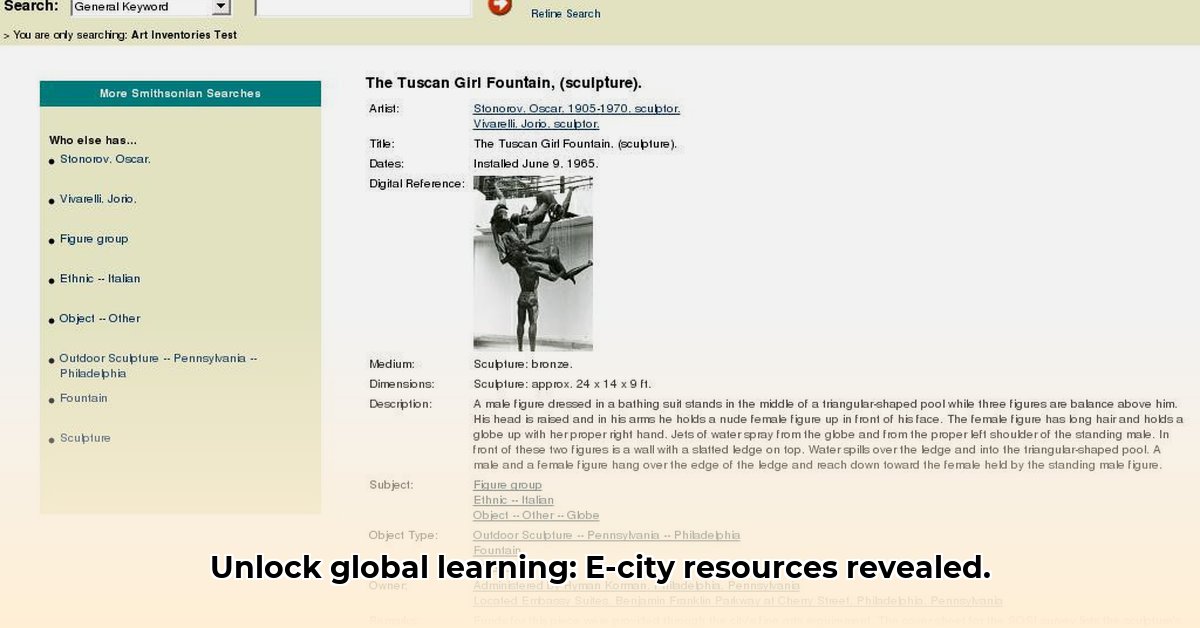Ever wondered what amazing learning opportunities are hidden in cities whose names begin with “E”? From ancient history to modern innovation, these cities offer a surprising variety of educational adventures. This guide explores the best learning spots in places like Edmonton, comparing them to other “E” cities around the world. We’ll uncover hidden gems, look at what works well in different cities, and share ideas on how to make learning even better in these places. For more “E” city information, check out this [comprehensive guide](https://theblaregroup.com/cities-that-start-with-e/). Get ready to discover cool resources and learn how education thrives in cities starting with “E”!
Learning Resources in Cities Starting with “E”: A Global Adventure
Embark on a global exploration to discover the fascinating learning resources available in cities starting with “E,” from historical landmarks to modern institutions. These cities, found across the globe, showcase incredible diversity, ranging from ancient historical sites to cutting-edge modern tech hubs. What unites them is a dedication to education, evidenced by thriving educational institutions, comprehensive library systems, and a wealth of cultural experiences, all contributing to lifelong learning journeys.
Erbil, Iraq: A Journey Through Time and Ancient Civilizations
Erbil, the capital of Iraqi Kurdistan, stands as one of the oldest continuously inhabited cities in the world, with a history stretching back at least 6,000 years. Its ancient citadel, a UNESCO World Heritage Site, dominates the city’s skyline and provides a tangible link to its rich past. Within Erbil’s modern educational institutions, such as Salahaddin University, students can delve into archaeology, history, and cultural studies, accessing a unique blend of ancient history and contemporary scholarship. The city’s museums, including the Erbil Civilization Museum, house artifacts that tell the story of Mesopotamia and the rise of civilization, offering unparalleled opportunities for historical study.
Edmonton, Canada: Prairie City, Research Hub, and Big Education
Edmonton, Alberta’s capital city, is a significant educational hub in Canada, anchored by the University of Alberta, a leading research institution. The university’s extensive library system and specialized research centers in fields like medicine, engineering, and environmental science attract students and researchers from around the world. Beyond the university, Edmonton’s diverse cultural institutions, including the Royal Alberta Museum and the Art Gallery of Alberta, contribute to a vibrant learning environment. Furthermore, science centers like Telus World of Science offer interactive exhibits for all ages, fostering a passion for science and technology. Edmonton’s commitment to lifelong learning is evident in its numerous public libraries, community programs, and initiatives promoting innovation and creativity.
Eureka, California: Coastal Learning and Marine Exploration
Eureka, located on California’s Redwood Coast, offers a distinctive educational experience focused on marine biology and environmental science. Humboldt State University, situated nearby in Arcata, has a strong marine science program, providing students with opportunities to study the unique ecosystems of the Pacific Northwest. The city’s proximity to Humboldt Bay and the Pacific Ocean allows for hands-on learning experiences, including field research, coastal monitoring, and marine conservation efforts. The Sequoia Park Zoo also offers educational programs focused on wildlife conservation and environmental awareness. Eureka’s natural setting fosters a deep appreciation for the environment and encourages students to pursue careers in marine science, conservation, and sustainable resource management.
Essen, Germany: From Coal Mines to Culture Transformation
Essen, located in the heart of the Ruhr region, showcases a remarkable transformation from an industrial center to a cultural hub. The Zollverein Coal Mine Industrial Complex, a UNESCO World Heritage Site, stands as a testament to the city’s industrial past and now houses museums, art galleries, and design studios. These cultural institutions offer valuable insights into the region’s history, industrial heritage, and urban renewal efforts. Educational programs and workshops at Zollverein provide opportunities for visitors of all ages to learn about architecture, design, and cultural heritage. Essen’s transformation exemplifies how a city can reinvent itself through education, culture, and innovation. The city’s numerous museums, theaters, and concert halls contribute to a vibrant cultural scene that enhances the learning experience.
East London, England: A Multicultural Mosaic and Arts Scene
East London is a vibrant and diverse area of London, known for its multicultural communities, artistic energy, and innovative spirit. The area is home to several universities and colleges, including Queen Mary University of London and the University of East London, which offer a wide range of academic programs and research opportunities. East London’s thriving arts scene provides a fertile ground for creative expression and learning, with numerous art galleries, theaters, and music venues showcasing the work of local and international artists. The area’s diverse communities offer opportunities for cultural exchange and intercultural understanding. Community centers, libraries, and adult education centers provide resources for lifelong learning and skills development. East London’s dynamic atmosphere fosters an environment where everyone can discover something to ignite their curiosity and creativity.
- Each “E” city boasts unique strengths, shaping distinctive educational ecosystems.
- Erbil offers unparalleled historical immersion.
- Edmonton provides access to cutting-edge research and vibrant cultural experiences.
Comparing Educational Ecosystems: A Global View, and Cultural Dynamism
Each “E” city has unique strengths. Erbil offers a journey through history; Edmonton provides access to research; Eureka offers coastal learning; Essen showcases industrial transformation; and East London highlights multicultural dynamism. By comparing these diverse educational ecosystems, we can identify best practices and innovative approaches that can be adapted and implemented in other cities. For example, Erbil’s integration of ancient history into its modern educational system offers a model for preserving cultural heritage and promoting historical awareness. Edmonton’s strong emphasis on research and innovation can inspire other cities to invest in science and technology. Eureka’s focus on marine science and environmental education can serve as a model for promoting sustainability and environmental stewardship. Essen’s transformation from an industrial center to a cultural hub demonstrates the power of education and culture to drive urban renewal. East London’s multicultural environment highlights the importance of diversity and cultural exchange in fostering creativity and innovation.
What’s Next?: The Future of Learning in “E” Cities
The future of learning in these cities looks bright, with opportunities for growth, innovation, and collaboration. Increased investment in technology, improved internet access, and stronger international partnerships can create even more enriching learning environments. As technology continues to evolve, online learning platforms, virtual reality, and artificial intelligence can enhance the learning experience and provide access to educational resources for students of all ages. International partnerships can facilitate student and faculty exchanges, collaborative research projects, and joint degree programs, fostering global understanding and cross-cultural collaboration. By embracing innovation and fostering collaboration, “E” cities can continue to lead the way in education and create a brighter future for their citizens.
Making Education More Accessible: Concrete Steps and Digital Infrastructure
Specific steps can be taken to improve access to education in these cities, ensuring that everyone has the opportunity to learn and grow. These steps include:
- Boost Digital Infrastructure: Expanding internet access will help bridge the gap for those lacking online resources and technological equity, especially in underserved communities.
- Offer Multilingual Materials: Making information available in various languages ensures everyone can participate, fostering inclusivity and promoting cultural understanding.
- Forge Partnerships: Collaboration between schools, community groups, and companies expands opportunities, creating a collaborative learning ecosystem and providing students with real-world experiences.
- Highlight Local Culture: Learning should reflect each city’s character, creating a stronger sense of identity and promoting cultural pride. Support for local arts, traditional crafts, and cultural events can enrich the learning experience and connect students to their heritage.
The learning resources in cities beginning with “E” offer a rich blend of historical significance, cultural depth, and modern innovation.
* Ongoing exploration of these cities promises more fascinating discoveries.
* Embracing diversity and investing in excellent education are key.
* Greater collaboration and knowledge sharing will enhance learning environments.
By embracing this diversity and investing in excellent education, we can unlock even more opportunities for learning and growth in these special places. The ongoing exploration of these cities and their educational resources promises to reveal even more fascinating discoveries in the years to come.
How to reconcile conflicting population data for cities starting with “E”
Let’s dive into the complexities of urban data and demographic insights. Finding accurate population figures for cities, especially those starting with “E,” can be surprisingly challenging. Different sources often present conflicting numbers. Why does this happen, and how can we make sense of population estimates? Inconsistent data collection methods, varying definitions of urban areas, and even simple errors contribute. But don’t worry—we’ll navigate these challenges.
Understanding the Problem: Why Conflicting Data and Boundary Definitions?
Imagine trying to assemble a puzzle with pieces from different boxes; some pieces might not fit, reflecting the inconsistencies we face with population data. Several factors contribute to this discrepancy:
- Data Collection Methods: Different organizations employ varied methodologies, influencing accuracy. Some rely on census data collected every ten years, while others use statistical models to estimate population changes annually.
- Defining Urban Areas: The boundaries of a city aren’t always clear-cut; ambiguous definition causes discrepancies and impacts data interpretation. For example, should the population of a metropolitan area be included, or just the people living within the city limits?
- Data Errors: Human error is inevitable; simple data entry mistakes can result in demographic inaccuracies. These errors can occur during data collection, processing, or analysis.
Reconciling Conflicting Data: A Step-by-Step Guide and Statistical Analysis
How to reconcile conflicting population data for cities starting with “E” requires a systematic approach, yielding consistent urban analytics.
- Gather Your Data: Compile population figures from multiple reputable sources,
- Spiritual Meaning of the Name Kimberly Explores Inner Strength and Divine Worth - November 30, 2025
- Unpacking Kim Meaning in Bible and Its Related Themes - November 29, 2025
- Decoding the Biblical Meaning of Kimberly and Spiritual Significance - November 28, 2025










